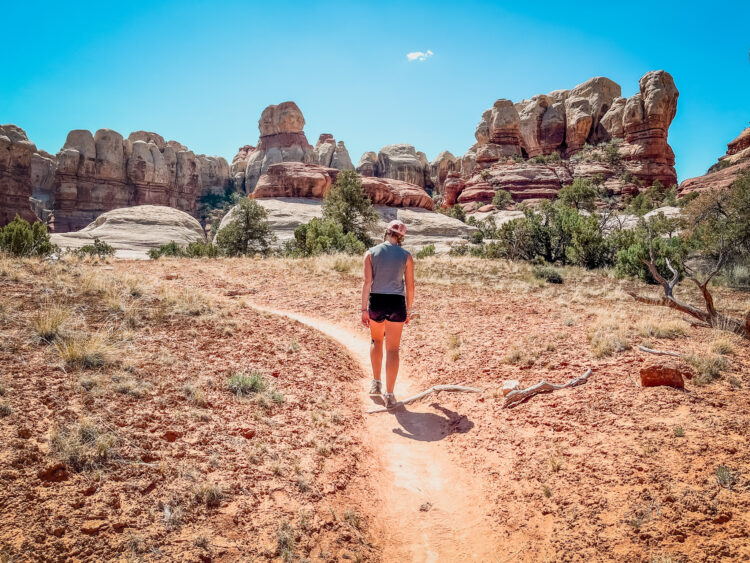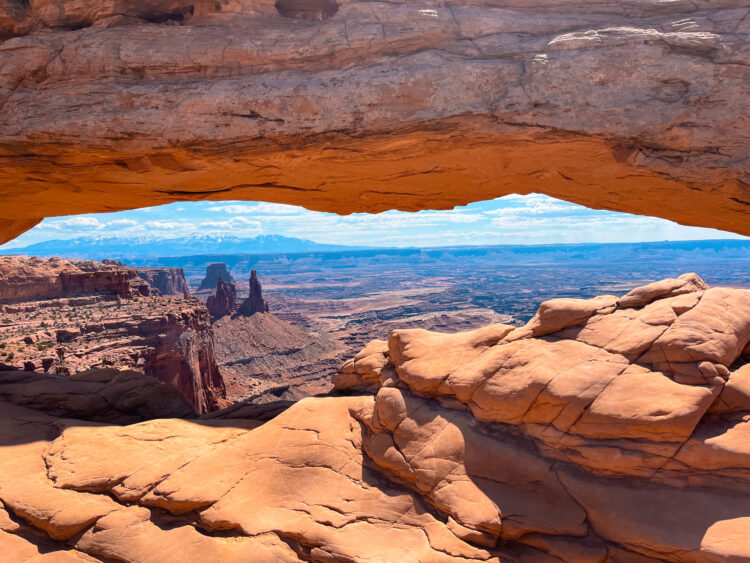Having comfortable hiking boots can make a huge difference on how much you will enjoy your hike, but that doesn’t mean you need to spend hundreds of dollars. Whether you are just getting started hiking or are looking for a new pair of boots, we’re here to help you find the best hiking boots under $100.
If you plan to hike extensively over the next few years, you may want to consider investing in a high-quality hiking boot, but for most people who enjoy hiking, a less expensive option will work well. This is also a great list if you have tweens and teens who still have growing feet and I’ve included a few options for kids whose feet are still growing.
As an affiliate, I may recieve compensation when you make a purchase through a link on this page. Thank you for your support.

Quick Look at the Best Hiking Boots Under 100 Dollars
These hiking boots were all priced below $100 at the time of writing this article, and we do our best to update prices, but you should check prices online to confirm the final purchase price. Several of these boots are priced at just under $100.
Boot Type | Approximate Cost | Check Prices | |
$$$ | |||
$$$ | |||
$$ | |||
$$$ | |||
$$ | |||
$$ | |||
$ |
What to look for When Buying the Best Hiking Boots Under $100
While you are shopping for a less expensive hiking boot, it’s important not to sacrifice quality and comfort.
There are several excellent options for hiking boots and shoes between $70-$100 but once you start looking below $70, you are likely to sacrifice something. If you don’t have the budget for something over $70, your best bet is to invest in a pair of good sneakers. Sneakers can be a good option for flat hikes but often lack ankle support and padding.
Here are the things to consider when shopping for hiking boots under 100 dollars:
Waterproof – depending on where you are hiking this may or may not be important to you. You should make sure your shoes have some waterproof ability. Many shoes will keep out light rain, but won’t stand up to a stream crossing or hiking in mud. Most shoes with mesh are not completely waterproof.
You can also buy a waterproof spray to make your shoes waterproof.
Breathability – Sometimes it’s worth trading waterproof for breathable shoes, especially if you will be hiking mostly in the summer or heat. Breathable shoes with have mesh sections.
Ankle Support (Hiking Shoes versus Hiking Boots) – Depending on the ankle height you will have more or less ankle support. Some people prefer less support to avoid rubbing and heavy boots. If you are mainly hiking on rocky terrain, or carrying a lot of weight you likely want more ankle support.
Comfort – you need comfortable shoes or boots for hiking. Generally you should go up one size when buying hiking boots and you should always break in your shoes around the house before heading off on a big hike. If you do need to hike with new hiking shoes or boots, bring along some band aids in case of rubbing or hot spots.
Durability – you want a pair of hiking boots that will last for years. Often you can extend the age of your boots by replacing laces or insoles, but other common breakpoints are the holes the laces pass through, where the different elements of the shoes meet with the sole, and the sole itself. While more expensive boots and shoes tend to last longer, you can still find several of the best hiking boots under $100 that don’t sacrifice durability.

Best Hiking Boots Under $100
Columbia Women’s Newton Ridge Plus Waterproof Amped Hiking Shoe
This is a top-notch hiking shoe for women and several of the colors are listed below $100. Even though it is described as a shoe, the high ankle support makes these shoes one of the best hiking shoes under $100 if you will be on trails with more challenging footing.
The shoes are also made from leather and are waterproof making them comparable to many more expensive options and are often rated as the best hiking boots for flat feet and the best hiking boots for plantar fasciitis.
Foxelli Men’s Hiking Boots
These are excellent waterproof hiking boots for under $100 for men. They are made from suede leather and come in several colors. The quality of the boots is comparable to better-known brands making them a great choice for your next hiking boot.
Like the women’s boot above, these hiking boots have ankle support so are good choices for rougher trail conditions.
Merrell Men’s Moab 2 Vent Mid Hiking Boot
These are the best breathable hiking boots for under $100 for men. With the combination of mesh and leather, they aren’t waterproof but are a great option if most of your hiking will be in the summer.
Merrell is a great brand that consistently offers high quality, so you can also look for similar shoes or boots.
Merrell Women’s Moab 2 Mid Waterproof Hiking Boot
These are excellent lightweight shoes and are the best hiking boots for under 100 dollars for women looking for breathable summer hiking boots. While they are waterproof technically, I’ve found these do get wet inside on muddy trails due to the mesh.
I find Merrell’s tend to run small, so it’s a good idea to go up a half size. If you are looking for the best hiking boots for women’s wide feet, note that you can order these in a wide.
Merrell Women’s MOAB 2 WTPF Hiking Shoe
Another shoe by Merrell, these are true hiking shoes (compared to hiking boots). They are designed for hikes with generally easy footing without lots of rocks and roots. This the pair of shoes my teenage daughter uses most of the time and we’ve found them versatile and high quality.
They aren’t completely waterproof compared to the all leather option above..
Merrell Men’s Moab 2 Vent Hiking Shoe
These are the men’s version of the Merrel hiking shoe and are the best hiking shoes under 100 for men who want a lightweight summer hiking shoe. They have breathable mesh and are mostly waterproof.
As with most hiking shoes, you are best off buying a 1/2 size bigger.
Northside Unisex-Child Rampart Mid Hiking Boot
These are the kid’s hiking boots that 2 of my kids have worn and my 10-year-old wears now. They have last and are still mostly waterproof. Since kids’ feet grow so quickly, it’s even more important to find an inexpensive option that is still durable and comfortable.
These come in a range of kids’ sizes and the toddler version has an extra velcro strap at the ankle for more support.
Tips for Breaking in the Best Hiking Boots Under $100
Every hiking boot should be broken in before you use it and especially before you head out into the woods for a long hike. Even if your shoes feel comfortable at the trailhead, you can easily get blisters. Below are some of the top tips for breaking in new hiking boots and hiking shoes.
- Start Slowly: Begin by wearing your new boots for short periods of time in controlled environments, such as around your house or during short walks. Gradually increase the duration to give your feet time to adjust.
- Wear the Right Socks: Use moisture-wicking socks made of synthetic or merino wool to reduce friction and keep your feet dry. Avoid cotton socks, as they retain moisture and can lead to blisters.
- Lacing Techniques: Experiment with different lacing techniques to find the right fit and prevent pressure points. A common technique is the “heel lock” or “lace lock,” which secures your heel in place and reduces slippage.
- Thin Liner Socks: In addition to your regular hiking socks, consider using thin liner socks. Liner socks can provide an extra layer of protection against friction and help prevent blisters.
- Proper Sizing: Ensure you’ve chosen the right size of hiking boots. Your toes should have some wiggle room, and your heels shouldn’t lift when you walk. Try on boots in the afternoon when your feet are naturally slightly swollen.
- Terrain Variety: As you increase the duration of wear, try different types of terrain to mimic the conditions you’ll encounter on the trail. This helps your boots conform to various angles and surfaces.
- Flex and Bend: To help soften the boot’s materials, flex and bend the sole and upper gently with your hands. This can help make the boots more pliable and comfortable.
- Use Moleskin or Tape: If you feel any hotspots or areas of friction developing, apply moleskin or athletic tape to those spots to reduce friction and prevent blisters.
- Carry Blister Treatment: Even with proper preparation, blisters might still occur. Carry blister treatment items like moleskin, blister pads, or a small roll of athletic tape in your hiking pack.
- Alternate Boots: If possible, switch between your new boots and your old, broken-in pair during longer hikes. This can help reduce the strain on your feet while still allowing you to break in the new boots.
- Listen to Your Feet: Pay attention to any discomfort or pain. Don’t push through severe discomfort, as this could lead to more serious issues down the line. It’s normal to experience some mild discomfort during the break-in process, but it should not be unbearable.
Did you find what you were looking for in the article: Best Hiking Boots Under $100? Did I miss your favorite boots? Share in the comments below.
If you are looking for more suggestions for hiking or adventure gear check out:
Common Questions about the Best Hiking Boots under $100
What materials should I look for in hiking boots under $100 to ensure durability and comfort?
When looking for hiking boots under $100, it’s essential to prioritize materials that offer a balance of durability and comfort. Some common materials to consider include synthetic fabrics, such as nylon or polyester, which are lightweight, breathable, and often more affordable than full-grain leather. Synthetic leather or suede can also be found in this price range and provide a good combination of durability and cost-effectiveness. Additionally, look for boots with sturdy rubber outsoles that provide traction on various terrains.
What are the best ways to maintain and care for hiking boots under $100 to maximize their lifespan?
Proper maintenance and care can significantly extend the lifespan of hiking boots, even those under $100. Here are some essential tips:
- Clean your boots after each hike using a soft brush or cloth to remove dirt and debris.
- Avoid using harsh chemicals or detergents that can damage the materials. Instead, use mild soap and water for cleaning.
- Allow your boots to dry naturally at room temperature. Avoid direct heat sources like heaters or sunlight, as they can cause the materials to dry out and crack.
- Apply a waterproofing treatment regularly to maintain water resistance. Check the manufacturer’s recommendations for the specific product you are using.
- Inspect the boots for any signs of wear or damage. Repair minor issues promptly to prevent them from worsening and affecting the boot’s performance.

Can I use these boots for other outdoor activities, such as backpacking or trail running?
While hiking boots under $100 may not offer the same advanced features and technologies as specialized footwear for activities like backpacking or trail running, they can still be suitable for light backpacking trips or occasional trail running. However, it’s important to consider the specific needs and demands of these activities. If you plan to engage in more intense or frequent backpacking or trail running, investing in footwear specifically designed for those activities may provide better performance and comfort in the long run.





















Pingback:15 Day Hike Essentials: Exactly What to Pack for Day Hiking - Chasing ADVNTR